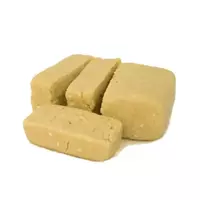Halwa sesame

Halva can be safely ranked among the national or traditional sweets of the states of Central Asia. It is also noteworthy that halvu in the East is considered not only a tasty, but also an incredibly useful food. The name halwa or حَلاوة is translated from Arabic as "sweetness. " In its culinary essence, halva is a dessert or oriental sweetness, which is made from seeds, nuts, sugar or its substitutes.
It is worth noting that in addition to all of us familiar halva from seeds or nuts, sweetness is usually made from vegetables and wheat flour. Any type of halva contains three main components in its composition - caramel and protein mass, as well as a foaming agent. Halva is based on a paste of oilseeds or nuts, as well as molasses or sugar syrup. At home, honey is more often used to produce halva.
As a foaming agent in the process of producing halva, licorice root or, the so-called soap root is used. Sesame halwa is considered one of the most sought-after and popular types of sweets. The taste properties of sesame halva have done their job and now sweetness occupies a worthy place among the favorite desserts of domestic consumers.
Composition of sesame halwa
It is worth noting that in addition to taste properties, sesame halva is distinguished by its high nutritional content. The calorie content of sesame halva primarily depends on the composition of the product. The average calorie level of sesame halva is 470 kcal per 100 grams of product. Sesame halwa contains sesame seeds or the interior of the seed.
Benefits of sesame halwa
By the way, halva made from the inside of the seed is called tachynous. Quite often, a mixture of seeds and their internal parts is present in the composition of sesame halva. In this case, the halwa is called sesame-tahinna. The benefits of sesame halva lie in the vitamin-mineral composition of the product, which contains vitamins of group E, as well as F.
In addition, the benefit of sesame halva lies in the high nutritional content of the product, as well as the content of such undoubtedly useful compounds as zinc, calcium, magnesium, manganese and others. We can say that the benefits of sesame halva are due to the unique natural composition of sesame seeds. The harm of sesame halva, however, as well as the benefits, lies in the composition of the product.
Harm to sesame halwa
Excessive consumption of the product in unlimited quantities can lead to consequences that are quite sad for the human body. Sesame halwa can be harmed by the digestive system as well as teeth. Therefore, do not abuse such a tasty tasty and certainly useful treat as sesame halva.
sesame halva 470.23 kCal
Energy value of sesame halva (Ratio of proteins, fats, carbohydrates - ju):
Proteins: 11.88 g (~ 48 kCal)
Fats: 28.79 g (~ 259 kCal)
Carbohydrates: 44.55 g (~ 178 kCal)
Energy ratio (bj | y): 10% | 55% | 38%
 Español
Español Français
Français Português
Português Русский
Русский 简体中文
简体中文 繁體中文
繁體中文 日本語
日本語 한국어
한국어 العربية
العربية Türkçe
Türkçe Қазақ
Қазақ Deutsch
Deutsch Italiano
Italiano Українська
Українська
